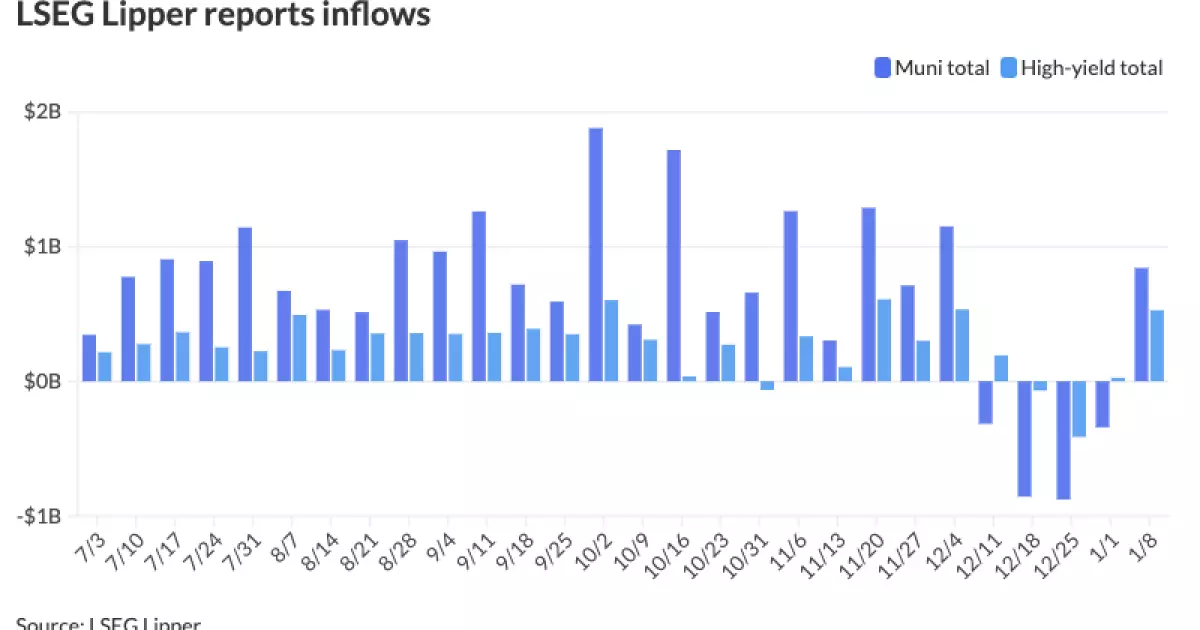In the early days of 2025, the municipal bond market is demonstrating intriguing stability. Although there were slight fluctuations in shorter maturities, the overall trend indicates resilience. This pattern emerged amidst a notably positive shift in municipal bond mutual fund flows, which reported inflows amounting to $842.4 million for the first week of January, according to recent LSEG Lipper data. This marks a significant turnaround from a four-week streak of outflows. The previous week had seen a modest outflow of $342.2 million, making this an important moment of recovery for investors.
What stands out is the impressive rebound in high-yield funds, which posted inflows of $527.1 million—an increase from just $26.3 million the week prior. Reflecting on these trends, James Welch, a municipal portfolio manager at Principal Asset Management, conveyed optimism regarding the municipal bond narrative for 2025. He asserts that this year’s market offers compelling entry points for investors, particularly as yields have reached levels not seen in the past year.
As yields climb to peak levels, taxable equivalent yields have been surging—hovering between 7% and 8% depending on credit standing and the specific yield curve segment. An analysis of ratios further reveals that municipalities are maintaining attractiveness. For instance, recent data showed the two-year municipal to U.S. Treasury (UST) ratio at 65%, with similar values recorded across other maturities. Such figures suggest a healthy balance and attractivity for municipal bonds relative to their Treasury counterparts, providing opportunities for savvy investors.
However, while the positive landscape unfolds, the issuance aspect remains noteworthy. The initial days of January epitomized a slower issuance process, influenced by the lingering holiday spirits. Notably, a significant component of the week’s market activity was marked by the pricing of a sizable $981.685 million deal from the Central Valley Energy Authority. As noted by Welch, the anticipation surrounding forthcoming issuance may define the market’s trajectory in the coming weeks.
Venturing into the month, the pipeline of deals promises to be substantial. Sizable upcoming offerings are expected, such as the $1.3 billion real estate transfer tax revenue bonds from the Triborough Bridge and Tunnel Authority and a significant $996.335 million second series revenue bond deal from San Francisco International Airport. Furthermore, projected deals involving multiple billion-dollar offerings from the University of California and the state of Washington highlight the growing trend of larger transactions, reflecting increasing financing and infrastructure needs.
This shift towards larger deals is emblematic of the changing dynamics of the municipal market, one that reflects a broader trend in financing strategies. Welch emphasizes that this evolution will become a cornerstone of the 2025 landscape, enabling municipalities to meet mounting demands for infrastructure enhancement effectively.
Nevertheless, uncertainty looms as the political climate shifts with the impending transition of the presidency. The potential implications of the Trump administration’s policies add complexity to the market framework. Market players are navigating various anxieties, particularly surrounding the potential elimination of the tax exemption for municipal bonds. While there are mixed opinions on the probability of such a change, it signifies the broader unpredictability that could lead to market volatility.
Welch highlights that while immediate effects may not be felt, the administrative changes will likely introduce logistical hurdles that could complicate policy implementation. As the municipal landscape braces for adjustments, it’s crucial to monitor how these dynamics unfold and their long-term impacts on investor sentiment.
In parallel with municipal trends, the money market sphere has also witnessed noteworthy activity. Tax-exempt municipal money market funds reported inflows of $4.085 billion, raising total assets to $139.335 billion. Coupled with a declining average seven-day yield of 2.04%, the market reflects an environment of competitive strategies amidst increased asset allocation to municipal sectors.
The Federal Open Market Committee (FOMC) minutes from December indicate a cautious mindset, contemplating inflationary pressures and their implications on future rate adjustments. While some economic indicators suggest stability, the ongoing discourse among FOMC participants indicates a close watch on inflation progression and its impact on future policy decisions.
As the multipronged dynamics of the municipal bond market unfold, 2025 can be characterized as a year ripe with opportunities. Investors and market participants must remain agile, adapting to the developing landscape while capitalizing on favorable conditions. Balancing cautious optimism while closely monitoring external influences will be key to navigating the complexities of the market.

